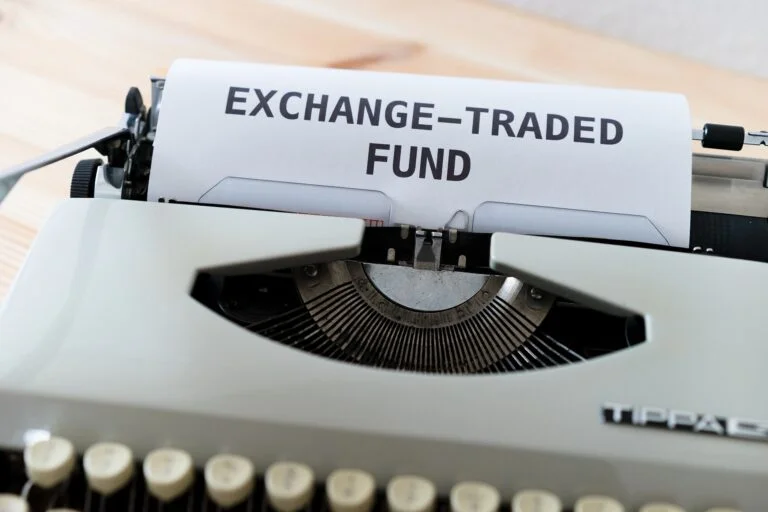1. Summary
In this article, we will talk about investing in ETFs and how to do it.
Investing in exchange-traded funds, or ETFs for short, is one of the most popular ways to invest your money.
ETFs are very flexible investment products that offer diversified exposure to a particular market or sector without having to directly purchase each stock individually.
This makes them ideal for those who want broad market exposure but don’t want to deal with all the maintenance and research required by regular mutual funds.
And if you are wondering what an exchange-traded fund is, then keep reading because you will learn everything you need to know about them!
2. What is an ETF?
ETFs are financial products that follow a specific index, such as the NIFTY 50 , BankNIFTY, or NIFTYMIDCAP Index.
They also track commodities, bonds, and other assets and allow investors to gain exposure to a variety of markets and assets all in one trade.
One of the biggest advantages of investing in ETFs is that they are very cost efficient.
You can trade a single ETF to gain exposure to a broad range of assets in the market.
Some ETFs are passive and automatically follow the index they are tracking.
Others are actively managed to provide you with a return that is specific to your investment strategy.
When you buy ETFs, you are taking a direct ownership position in the assets they own.
3. How To Invest In ETFs
There are two main ways to invest in ETFs:
Directly via a broker or via an online brokerage service. – Directly Via A Broker: If you are in the market to buy a single ETF, you can go through a broker who will allow you to make your investment directly.
This is usually the most convenient way to invest in ETFs, as you can easily open an account with a broker and start trading. However there are some drawbacks to this approach.
Most brokers charge a fee for trading ETFs, so if you are looking to get more bang for your buck, this is not the way to go.
You may also need to research the different brokerage accounts that are available. – Via An Online Brokerage Service: With an online brokerage service, you don’t have to deal with the hassle of opening an account and dealing with brokers, instead you can access a wide range of trading instruments and make trades online.
There are a variety of online brokerage services to choose from, some of which are brokers that specialize in ETFs such as Motiwal Oswal and HDFC .
A few things to keep in mind when investing in ETFs via an online brokerage is that you may incur a fee for trading, depending on the brokerage.
You will also want to make sure you’re using a broker that specializes in ETFs as they may offer you a wider range of products and services.
4. Pros of Investing in ETFs

1) Cost Efficient:
One of the best things about investing in ETFs is that they are extremely cost efficient.
In fact, some of the most popular ETFs cost less than ₹500 to buy and hold, making them an ideal way for investors who want to diversify their portfolio without having to spend a lot of time analyzing investments.
2) Broad Exposure:
Another great thing about investing in ETFs is that they provide broad exposure to major asset classes and markets.
For example, if you want to gain exposure to the US economy, investing in an ETF that tracks the S&P 500 is a great way to do it as it includes over 500 of the largest and most influential companies in the country.
3) Scalability:
ETFs are extremely scalable and can be bought and sold quickly without having to worry about significant trading volumes. This allows investors to get in and out of the market quickly while maintaining a low trading cost.
5. Cons of Investing in ETFs
1) Lack of Transparency:
One of the biggest cons of investing in ETFs is that they are essentially a closed-end investment product and therefore lack transparency.
This means that it’s hard to know if a particular ETF is underperforming or if it’s simply following its index.
2) Lack of Investment Tools:
ETFs are designed to be low-cost, broad-based investments that are easy to buy and sell, but many investors prefer to use more sophisticated investment tools that offer them a greater amount of control over their investment strategy. Unfortunately, many online brokerage accounts aren’t geared towards ETFs and may provide fewer investment tools than you’d otherwise get with a traditional broker account.
6. Final Words: Should You Invest In Exchange Traded Funds?
We hope by the end of this article, you feel confident enough to start investing in ETFs.
Brokers like Upstox make it easy to buy and sell ETFs at a Free cost, making it an easy way to diversify your investment portfolio.
With the right broker and some research, you can start investing in ETFs and reap the benefits of diversified market exposure with minimal time investment and risk.
You can also diversify your portfolio by investing in ETFs, which are basically index investments that let you trade a range of stocks.
It’s very easy to buy and sell an ETF, but there’s a big risk of losing money because the ETF may not closely track the index it’s based on.
